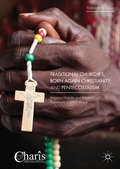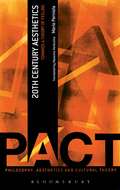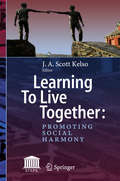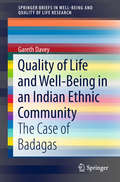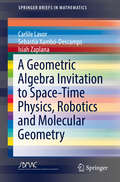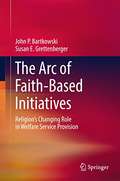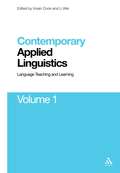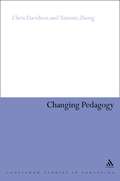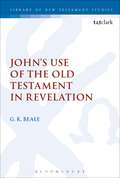- Table View
- List View
Where the Eagles are Gathered: The Deliverance of the Elect in Lukan Eschatology (The Library of New Testament Studies #241)
by Steven BridgeAlthough many scholars consider Luke 17:22-37 to be "the most important eschatological passage in Luke-Acts," few agree on the precise meaning of the enigmatic proverb which forms its conclusion (Luke 17:37). Generally, Jesus' logion is taken to convey a macabre image of impending judgement. However, this study offers fresh literary, redactional, and historical evidence to suggest that Luke recast Jesus' saying in order to describe something much more glorious--the deliverance of the elect. Examination of the material elsewhere in Luke-Acts corroborates Luke's expectation of an ethereal reunion, and suggests that this hope constitutes the most characteristic feature of Lukan eschatology.
Deleuze and the Schizoanalysis of Cinema (Schizoanalytic Applications)
by Ian Buchanan Patricia MacCormackIn 1971, Deleuze and Guattari's collaborative work, Anti-Oedipus: Capitalism and Schizophrenia caused an international sensation by fusing Marx with a radically rewritten Freud to produce a new approach to critical thinking, which they provocatively called "schizoanalysis." Deleuze and the Schizoanalysis of Cinema explores the possibilities of using this concept to investigate cinematic works in both the Hollywood and non-Hollywood tradition. It attempts to define what a schizoanalysis of cinema might be and introduces a variety of ways in which a schizoanalysis might be applied. This collection opens up a fresh field of inquiry for Deleuze scholars and poses an exciting challenge to cinema studies in general. Featuring some of the most important cinema studies scholars working on Deleuze and Guattari today, Deleuze and the Schizoanalysis of Cinema is a cutting edge collection that will set the agenda for future work in this area. Contributors include: Gregory Flaxman, Amy Herzog, Joe Hughes, Gregg Lambert, Patricia MacCormack, Bill Marshall, David Martin-Jones, Elena Oxman, Patricia Pisters, Anna Powell and Mark Riley.
Samson and Delilah in Medieval Insular French: Translation and Adaptation (The New Middle Ages)
by Catherine LégluSamson and Delilah in Medieval Insular French investigates several different adaptations of the story of Samson that enabled it to move from a strictly religious sphere into vernacular and secular artworks. Catherine Léglu explores the narrative’s translation into French in medieval England, examining the multiple versions of the Samson narrative via its many adaptations into verse, prose, visual art and musical. Utilizing a multidisciplinary approach, this text draws together examples from several genres and media, focusing on the importance of book learning to secular works. In analysing this Biblical narrative, Léglu reveals the importance of the Samson and Delilah story as a point of entry into a fuller understanding of medieval translations and adaptations of the Bible.
Samson and Delilah in Medieval Insular French: Translation and Adaptation (The New Middle Ages)
by Catherine LégluSamson and Delilah in Medieval Insular French investigates several different adaptations of the story of Samson that enabled it to move from a strictly religious sphere into vernacular and secular artworks. Catherine Léglu explores the narrative’s translation into French in medieval England, examining the multiple versions of the Samson narrative via its many adaptations into verse, prose, visual art and musical. Utilizing a multidisciplinary approach, this text draws together examples from several genres and media, focusing on the importance of book learning to secular works. In analysing this Biblical narrative, Léglu reveals the importance of the Samson and Delilah story as a point of entry into a fuller understanding of medieval translations and adaptations of the Bible.
Traditional Churches, Born Again Christianity, and Pentecostalism: Religious Mobility and Religious Repertoires in Urban Kenya (Christianity and Renewal - Interdisciplinary Studies)
by Yonatan N. GezIn Kenya's vibrant urban religious landscape, where Pentecostal and traditional churches of various orientations live side by side, religious identity tends to overflow a single institutional affiliation. While Kenya’s Christianity may offer modes of coping with the fragilities of urban life, it is subject to repeated crises and schisms, often fueled by rumors and accusations of hypocrisy. In order to understand the unfolding of Kenyans’ dynamic religious identities, and inspired by the omnipresent distinction between ‘religious membership’ and ‘church visits,’ Yonatan N. Gez considers the complementary relations between a center of religious affiliation and expansion towards secondary practices. Building on this basic distinction, the book develops a theoretical innovation in the form of the ‘religious repertoire’ model, which maps individuals’ religious identities in terms of three intertwined degrees of practice.
Traditional Churches, Born Again Christianity, and Pentecostalism: Religious Mobility and Religious Repertoires in Urban Kenya (Christianity and Renewal - Interdisciplinary Studies)
by Yonatan N. GezIn Kenya's vibrant urban religious landscape, where Pentecostal and traditional churches of various orientations live side by side, religious identity tends to overflow a single institutional affiliation. While Kenya’s Christianity may offer modes of coping with the fragilities of urban life, it is subject to repeated crises and schisms, often fueled by rumors and accusations of hypocrisy. In order to understand the unfolding of Kenyans’ dynamic religious identities, and inspired by the omnipresent distinction between ‘religious membership’ and ‘church visits,’ Yonatan N. Gez considers the complementary relations between a center of religious affiliation and expansion towards secondary practices. Building on this basic distinction, the book develops a theoretical innovation in the form of the ‘religious repertoire’ model, which maps individuals’ religious identities in terms of three intertwined degrees of practice.
Essentials of Partial Differential Equations: With Applications
by Marin Marin Andreas ÖchsnerThis book offers engineering students an introduction to the theory of partial differential equations and then guiding them through the modern problems in this subject. Divided into two parts, in the first part readers already well-acquainted with problems from the theory of differential and integral equations gain insights into the classical notions and problems, including differential operators, characteristic surfaces, Levi functions, Green’s function, and Green’s formulas. Readers are also instructed in the extended potential theory in its three forms: the volume potential, the surface single-layer potential and the surface double-layer potential. Furthermore, the book presents the main initial boundary value problems associated with elliptic, parabolic and hyperbolic equations. The second part of the book, which is addressed first and foremost to those who are already acquainted with the notions and the results from the first part, introduces readers to modern aspects of the theory of partial differential equations.
Biotechnologies of Crop Improvement, Volume 2: Transgenic Approaches
by Satbir Singh Gosal Shabir Hussain WaniDuring the past 15 years, cellular and molecular approaches have emerged as valuable adjuncts to supplement and complement conventional breeding methods for a wide variety of crop plants. Biotechnology increasingly plays a role in the creation, conservation, characterization and utilization of genetic variability for germplasm enhancement. For instance, anther/microspore culture, somaclonal variation, embryo culture and somatic hybridization are being exploited for obtaining incremental improvement in the existing cultivars. In addition, genes that confer insect- and disease-resistance, abiotic stress tolerance, herbicide tolerance and quality traits have been isolated and re-introduced into otherwise sensitive or susceptible species by a variety of transgenic techniques. Together these transformative methodologies grant access to a greater repertoire of genetic diversity as the gene(s) may come from viruses, bacteria, fungi, insects, animals, human beings, unrelated plants or even be artificially derived. Remarkable achievements have been made in the production, characterization, field evaluation and commercialization of transgenic crop varieties worldwide. Likewise, significant advances have been made towards increasing crop yields, improving nutritional quality, enabling crops to be raised under adverse conditions and developing resistance to pests and diseases for sustaining global food and nutritional security. The overarching purpose of this 3-volume work is to summarize the history of crop improvement from a technological perspective but to do so with a forward outlook on further advancement and adaptability to a changing world. Our carefully chosen “case studies of important plant crops” intend to serve a diverse spectrum of audience looking for the right tools to tackle complicated local and global issues.
Chemistry and Chemical Technologies in Waste Valorization (Topics in Current Chemistry Collections)
by Carol Sze LinThe series Topics in Current Chemistry Collections presents critical reviews from the journal Topics in Current Chemistry organized in topical volumes. The scope of coverage is all areas of chemical science including the interfaces with related disciplines such as biology, medicine and materials science. The goal of each thematic volume is to give the non-specialist reader, whether in academia or industry, a comprehensive insight into an area where new research is emerging which is of interest to a larger scientific audience. Each review within the volume critically surveys one aspect of that topic and places it within the context of the volume as a whole. The most significant developments of the last 5 to 10 years are presented using selected examples to illustrate the principles discussed. The coverage is not intended to be an exhaustive summary of the field or include large quantities of data, but should rather be conceptual, concentrating on the methodological thinking that will allow the non-specialist reader to understand the information presented. Contributions also offer an outlook on potential future developments in the field.Chapters "Sonocatalysis: A Potential Sustainable Pathway for the Valorization of Lignocellulosic Biomass and Derivatives", "Valorisation of Biowastes for the Production of Green Materials Using Chemical Methods" and "Green and Sustainable Separation of Natural Products from Agro-Industrial Waste: Challenges, Potentialities, and Perspectives on Emerging Approaches" are available open access under a Creative Commons Attribution 4.0 International License via link.springer.com.
Direct Speech, Self-presentation and Communities of Practice: Modern Greek Narratives
by Sofia LampropoulouThis book deals with speech representation in Greek adolescents' storytelling and investigates how members of different communities of practice present themselves and other characters as interactional protagonists through the stories they tell. The work puts forth a dynamic approach that examines (direct) speech representation at the local and the broader socio-cultural context in which it is embedded. The concept of community of practice accounts for direct speech variation, and direct speech is seen as the linguistic manifestation of shared repertoire of particular communities of practice. The book combines qualitative with quantitative methods of study and brings together relevant theories of speech representation, narrative analysis and self-presentation.
Heidegger, Ethics and the Practice of Ontology (Continuum Studies in Continental Philosophy)
by David WebbHeidegger, Ethics and the Practice of Ontology presents an important new examination of ethics and ontology in Heidegger. There remains a basic conviction throughout Heidegger's thought that the event by which Being is given or disclosed is somehow 'prior' to our relation to the many beings we meet in our everyday lives. This priority makes it possible to talk about Being 'as such'. It also sanctions the relegation of ethics to a secondary position with respect to ontology. However, Heidegger's acknowledgement that ontology itself must remain intimately bound to concrete existence problematises the priority accorded to the ontological dimension. David Webb takes this bond as a key point of reference and goes on to develop critical perspectives that open up from within Heidegger's own thought, particularly in relation to Heidegger's debt to Aristotelian physics and ethics. Webb examines the theme of continuity and its role in the constitution of the 'as such' in Heidegger's ontology and argues that to address ontology is to engage in an ethical practice and vice versa.
The Northern Danelaw: Its Social Structure, c.800-1100
by D. M. HadleyInvestigating the changing nature of lorship and peasant statuses, the transformation of estate structures, the emergence of villages, and the development of the parish system, D. M. Hadley also explains the peculiarities of the northern Danelaw and reassesses the impact of the Scandinavian settlements on its society and culture.A detailed local study is combined with a consideration of wider issues concerning Anglo-Saxon England and lond, and short-term changes unrelated to successive conquests.
20th Century Aesthetics: Towards A Theory of Feeling (Philosophy, Aesthetics and Cultural Theory)
by Mario Perniola Massimo VerdicchioIn our contemporary age aesthetics seems to crumble and no longer be reducible to a coherent image. And yet given the vast amount of works in aesthetics produced in the last hundred years, this age could be defined "the century of aesthetics†?. 20th Century Aesthetics is a new account of international aesthetic thought by Mario Perniola, one of Italy's leading contemporary thinkers. Starting from four conceptual fields – life, form, knowledge, action - Perniola identifies the lines of aesthetic reflection that derive from them and elucidates them with reference to major authors: from Dilthey to Foucault (aesthetics of life), from Wölfflin to McLuhan and Lyotard (aesthetics of form), from Croce to Goodman (aesthetics and knowledge), from Dewey to Bloom (aesthetics and action). There is also a fifth one that touches on the sphere of affectivity and emotionality, and which comes to aesthetics from thinkers like Freud, Heidegger, Wittgenstein, Lacan, Derrida and Deleuze. The volume concludes with an extensive sixth chapter on Japanese, Chinese, Indian, Islamic, Brazilian, South Korean and South East Asian aesthetic thought and on the present decline of Western aesthetic sensibility.
Learning To Live Together: Promoting Social Harmony
by J. A. KelsoThis book is devoted to the issue of how we can learn to live together in the face of division and conflict. It is dedicated to the life and work of a remarkable human being, Dr Epimenidis Haidemenakis, scientist, statesman, visionary leader, President Emeritus of the International S.T.E.P.S. Foundation and founding father of The Olympiads of the Mind (OM). The monograph consists of a collection of papers presented at the 8th and 9th Olympiads of the Mind held in Washington, DC and Chania, Crete respectively. Distinguished international scholars, government and corporate representatives, leading researchers and academics from multiple disciplines and Nobel Laureates Leon Lederman (Physics, 1988), Martin Perl (Physics, 1995) and Yuan T. Lee (Chemistry, 1986) address a broad range of issues all with the aim of improving the human condition and achieving cooperation among the people of the world. The topics include the environment, sustainability and security; diversity and how to achieve integration and peace among people in a fractured world; the important role of brain research; how to overcome poverty and inequality; how to enhance creativity and improve education at all levels; and how new technologies and tools can be used for common benefit. The culmination of the book is a call to action, to join what one might call the “OM Movement”—bringing the best minds in the world together to create solutions to world issues so that we can all live together in harmony.
Quality of Life and Well-Being in an Indian Ethnic Community: The Case of Badagas (SpringerBriefs in Well-Being and Quality of Life Research)
by Gareth DaveyThis book explores the quality of life among Badagas, an ethnic minority group in South India, as they navigate a society in flux, with specific reference to rural-to-urban migration and new media. At an empirical level, it reveals how Badagas understand themselves and the multifaceted changes in their culture and daily lives, exploring a pertinent concern at the forefront of debate about the future from a global perspective. The book draws attention to the fact that people are adopting flexible identities and lifestyles in an attempt to survive and thrive in a changing India and world, a new ‘Indian-ness’ shaped at the local level. It offers a timely update on previous research on Badagas, which dates to the 1990s, and also serves as an important case study on people’s experiences of the social and economic transformation of Indian society as they become accustomed to new ideas, products, and ways of life. As such, it is a must-read for all those interested in quality of life in India and developing societies.
A Geometric Algebra Invitation to Space-Time Physics, Robotics and Molecular Geometry (SpringerBriefs in Mathematics)
by Carlile Lavor Sebastià Xambó-Descamps Isiah ZaplanaThis book offers a gentle introduction to key elements of Geometric Algebra, along with their applications in Physics, Robotics and Molecular Geometry. Major applications covered are the physics of space-time, including Maxwell electromagnetism and the Dirac equation; robotics, including formulations for the forward and inverse kinematics and an overview of the singularity problem for serial robots; and molecular geometry, with 3D-protein structure calculations using NMR data. The book is primarily intended for graduate students and advanced undergraduates in related fields, but can also benefit professionals in search of a pedagogical presentation of these subjects.
The Arc of Faith-Based Initiatives: Religion’s Changing Role in Welfare Service Provision
by John P. Bartkowski Susan E. GrettenbergerThis volume offers an in-depth examination of a diverse range of faith-based programs implemented in three different geographical locales: family support in rural Mississippi, transitional housing in Michigan, and addiction recovery in the Pacific Northwest (Washington-Oregon). Various types of religious service providers—faith-intensive and faith-related—are carefully examined, and secular organizations also serve as an illuminating point of comparison. Among other insights, this book reveals how the “three C’s” of social service provision—programmatic content, organizational culture, and ecological context—all combine to shape the delivery of welfare services in the nonprofit world. This book warns against simplistic generalizations about faith-based organizations. Faith-based providers exhibit considerable diversity and, quite often, remarkable resilience in the face of challenging social circumstances. An appreciation of these nuances is critical as policies concerning faith-based organizations continue to evolve.
DNA Barcoding and Molecular Phylogeny
by Subrata Trivedi Hasibur Rehman Shalini Saggu Chellasamy Panneerselvam Sankar K. GhoshThis book includes a multitude of aspects of DNA barcoding and molecular phylogeny along with some case studies which will be beneficial to researchers and academics around the globe in a total of 27 chapters. Bioinformatics is an important part of DNA barcoding and the concept of R in DNA Barcoding is a very recent development. This book contains a full chapter devoted to this very important topic. Further areas where DNA barcoding can be applied are: management of invasive alien species, plant animal interactions, forensic botany, clinical microbiology especially in relation to infection management, DNA database management, among others. This book also includes very useful information related to the DNA barcoding and molecular phylogeny of microbes, aquatic plants, algae, mosquitoes, elasmobranchs, fishes, reptiles, birds and ruminant mammals. Some unique case studies describe DNA barcoding of reptiles dwelling in Saudi Arabian deserts, DNA barcoding of a high altitude medicinal plant, genetic variation studies in both wild and hatchery populations of Anabas testudineus, DNA Barcoding and molecular phylogeny of Ichthyoplankton and juvenile fishes of Kuantan River in Malaysia.
Contemporary Applied Linguistics Volume 1: Volume One Language Teaching and Learning (Contemporary Studies in Linguistics)
by Vivian Cook Li WeiWritten by internationally renowned academics, this volume provides a snapshot of the field of applied linguistics, and illustrates how linguistics is informing and engaging with neighbouring disciplines.The contributors present new research in the 'traditional' areas of applied linguistics, including multilingualism, language education, teacher-learner relationships, and assessment. It represents the best of current practice in applied linguistics, and will be invaluable to students and researchers looking for an overview of the field.
Neanderthals in the Levant: Behavioural Organization and the Beginnings of Human Modernity (New Approaches to Anthropological Archaeology)
by Donald O. HenryThe volume traces the controversy that revolves around the bio-cultural relationships of Archaic (Neanderthal) and Modern humans at global and regional, Levantine scales. The focus of the book is on understanding the degree to which the behavioral organization of Archaic groups differed from Moderns. To this end, a case study is presented for a 44-70,000 year old, Middle Paleolithic occupation of a Jordanian rockshelter. The research, centering on the spatial analysis of artifacts, hearths and related data, reveals how the Archaic occupants of the shelter structured their activities and placed certain conceptual labels on different parts of the site. The structure of Tor Faraj is compared to site structures defined for modern foragers, in both ethnographic and archaeological contexts, to measure any differences in behavioral organization. The comparisons show very similar structures for Tor Faraj and its modern cohorts. The implications of this finding challenge prevailing views in the emergence of modern human controversy in which Archaic groups are thought to have had inferior cognition and less complex behavioral-social organization than modern foragers. And, it is generally thought that such behaviors only emerged after the appearance of the Upper Paleolithic, dated some 10-20,000 years later than the occupation of Tor Faraj.
Changing Pedagogy: Analysing ELT Teachers in China
by Xin-Min Zheng Chris DavisonChina's growing economic, military and political stability have, for the first time, started to gain international recognition. As China increasingly opens up to the world, its unique role in the context of economic globalization is becoming more pronounced, which is exemplified by its recent membership of the WTO and Beijing's successful bid to host the Olympic Games. Unsurprisingly, this has resulted in an explosion in the popularity of English language learning in China, which has, in turn, led to radical reform of the curricula, teaching methods, teacher education and assessment system in China in order to improve standards. This fascinating monograph explores the nature of the implemented English language curriculum in China, focussing, in particular, on the pedagogy of secondary school teachers. There follows an insightful analysis into how such teachers, in different situations and with different backgrounds and motivations, make decisions about what and how they teach, and the extent to which they adapt the promoted methods in the their individual teaching environments. The authors then use their findings to propose an innovative and coherent framework, which has far-reaching consequences for pedagogy in China and across the world.
John's Use of the Old Testament in Revelation (The Library of New Testament Studies #166)
by Gregory K. BealeThis book explores the variety of ways John contextually uses the Old Testament in the Apocalypse. The introduction surveys and evaluates recent studies, which have been divided over the issue of whether or not John uses the Old Testament with sensitivity to its original literary context (Beale, Fekkes and Bauckham argue in the affirmative, while Ruiz and Moyise contend that this was not John's focus and see implications for 'reader-response criticism'). The remainder of the book looks at various ways in which John uses the Old Testament and argues that there is a reciprocal interpretative relationship between the Old Testament and the Apocalypse. Studies of special interest concern the bearing of the Old Testament on Revelation's eschatology, on the issue of the millennium, and on the thorny problem of the grammatical solecisms.
God Still Matters (Continuum Icons)
by Herbert McCabeHerbert McCabe, who died in 2001, was one of the most intelligent Roman Catholic thinkers of the twentieth century. An influence on philosophers such as Anthony Kenny and Alasdair MacIntyre he was also befriended by poets and literary critics such as Seamus Heaney and Terry Eagleton. Equally at home in philosophy and theology, he despised jargon and intellectual posturing as a substitute for reason and argument. At the time of his death, he left a wealth of unpublished material- so outstanding in its quality and originality that it is surprising that it was never published in book form. This is now put to rights. In God Still Matters we have the chance to read McCabe on the topics that interested him most - philosophy of God, Christology, Fundamental theology, Sacramental theology and ethics. No-one who reads this volume will doubt that McCabe was one of the outstanding Christian thinkers of his generation and the epitome of Dominican intellectual openness and rigour.
Bioinformatics and the Cell: Modern Computational Approaches in Genomics, Proteomics and Transcriptomics
by Xuhua XiaThis second edition integrates the more technical and mathematical aspects of bioinformatics with concrete examples of their application to current research problems in molecular, cellular and evolutionary biology. This broad, unified approach is made possible, in large part, by the very wide scope of Dr. Xia’s own research experience. The integration of genomics, proteomics and transcriptomics into a single volume makes this book required reading for anyone entering the new and emerging fields of Systems Biology and Evolutionary Bioinformatics.
Functional and Logic Programming: 14th International Symposium, FLOPS 2018, Nagoya, Japan, May 9–11, 2018, Proceedings (Lecture Notes in Computer Science #10818)
by John P. Gallagher Martin SulzmannThis book constitutes the proceedings of the 14th International Symposium on Functional and Logic Programming, FLOPS 2018, held in Nagoya, Japan, in May 2018. The 17 papers presented in this volume were carefully reviewed and selected from 41 submissions. They cover all aspects of the design, semantics, theory, applications, implementations, and teaching of declarative programming focusing on topics such as functional-logic programming, re-writing systems, formal methods and model checking, program transformations and program refinements, developing programs with the help of theorem provers or SAT/SMT solvers, language design, and implementation issues.



